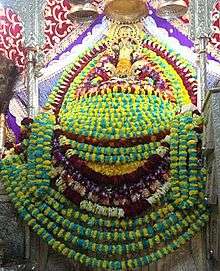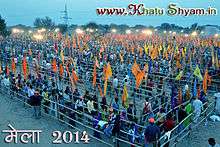Khatushyam Temple
| Khatushyam Temple | |
|---|---|
 Idol of Khatu Shyam in Khatushyam temple shree shyam Reengus dham | |
| Other names | Maurvinandan, Sheesh Ke Daani |
In Hinduism, Khatushyam is a name and manifestation of Barbarik, grandson of Bhima and Hidimba(sister of demon Hidimb) , son of Ghatotkach and Kamkantkata / Maurvi (daughter of Demon Mur) as per Skandpurana. This manifestation is especially popular in the Indian state of Rajasthan and Haryana. The original Sanskrit name Barbarīka is often replaced in Rajasthan by the Hindi version, Barbarīk, often written as Barbareek.
Barbarika had obtained a boon from Krishna to the effect that he would be known by Krishna's own name (Shyam) in the Kaliyuga era (presently ongoing) and worshiped. Krishna had declared that Barbarika's devotees would be blessed just by pronouncing his name from the bottom of their hearts. Their wishes would be granted and troubles removed if they worship Shyamji (Barbarika) with a true piety.
Temple
After the Mahābhārata battle, Barbarika's head was drowned in the river named Rupawati by Lord Krishna giving lots of blessings.After many years when Kalyug started the head was found buried in the village of Khatu (District- Sikar) in present-day Rajasthan. The location was obscured until well after the Kaliyuga period began. Then, on one occasion, milk started flowing spontaneously out of a cow's udder when she neared the burial spot. Amazed at this incident, the local villagers dug the place up and the buried head was revealed. The head was handed over to a Brahmin who worshipped it for many days, awaiting divine revelations as to what was to be done next. Roopsingh Chauhan, king of Khatu, then had a dream where he was inspired to build a temple and install the head therein. Subsequently, a temple was built and the idol was installed on the 11th day of the Shukla Paksha (bright half) of the month of Phagun.
There is another, only slightly different version of this legend. Roopsingh Chauhan was the ruler of Khatu. His wife, Narmada Kanwar, once had a dream in which the deity instructed her to take his image out of the earth. The indicated place (now known as Shyam Kund) when then dug up. Sure enough, it yielded the idol, which was duly enshrined in the temple.
The original temple was built in 1027 AD by Roopsingh Chauhan, after his wife Narmada Kanwar, saw dream about the buried idol. The place where the idol was dug out from is called Shyam Kund.[1] In 1720 AD, a nobleman known as Diwan Abhaisingh renovated the old temple, at the behest of the then ruler of Marwar. The temple took its present shape at this time and the idol was enshrined in the sanctum sanctorum. The idol is made of rare stone. Khatushyam is the family deity of a large number of families.
His another temple is located at Vasna, Ahmedabad, Gujarat where people are coming with their newly born child to have blessings of Khatushyam. Here he is known as Baliya Dev.
Architectural features
The temple is architecturally rich. Lime mortar, marble and tiles have been used in constructing the structure. The shutters of the sanctum sanctorum are beautifully covered with silver sheet. Outside is the prayer hall, named Jagmohan. The hall is large in size (measuring 12.3 m x 4.7 m) and its walls are elaborately painted, depicting mythological scenes. The entrance gate and exit gate are made of marble; their brackets are also of marble and feature ornamental floral designs.
Precincts
There is an open space in front of the entrance gate of the temple. The Shyam Bagicha is a garden near the temple from where flowers are picked to be offered to the deity. The Samadhi of Aloo Singh, a great devotee, is located within the garden.
The Gopinath temple lies to the south-east of the main temple. The Gaurishankar temple also lies nearby. There is an interesting tale associated with the Gaurishankar temple. It is said that some soldiers of the Mughal emperor Aurangzeb wanted to destroy this temple. They attacked the Shiva lingam enshrined within this temple with their spears. Immediately, fountains of blood appeared from the Shiva Lingam. The soldiers ran away, terrified. One can still see the mark of the spear on the Lingam.
Khatushyam main temple is located at Khatu Town about 80 km from Jaipur. Devotees are requested to take route via Ringus.
Observances and festivals
Barbarika is worshiped as Shyam, being Krishna himself. Therefore, the flavour of the festivities reflects the playful and vibrant nature of Krishna. The festivals of Krishna Janmaashtami, Jhool Jhulani Ekadashi, Holi and Vasant Panchami are celebrated with gusto in the temple. The Phalguna Mela detailed below is the principal annual festival.
Hundreds of devotees visit the temple every day. Newly married couples come to pay homage and newborn babies are brought to the temple for their mundan (the first hair-shaving) ceremony. An elaborate aarti is performed at the temple five times a day. These are:
- Mangala Aarti: performed in the early morning, when temple is open.
- Shringaar Aarti: performed at the time of make-up of Baba Shyam. The idol is grandly ornamented for this aarti.
- Bhog Aarti: performed at noon when bhog (Prasadam) is served to the Lord.
- Sandhya Aarti: performed in the evening, at sunset.
Two special hymns, the "Shri Shyam Aarti" and the "Shri Shyam Vinati," are chanted on all these occasions. The Shyam mantra is another litany of the Lord's names that is chanted by devotees.
Other particular observances include:
Shukla Ekadashi and Dwadashi: The 11th and 12th days of the bright half of every month in the Hindu calendar is of special significance to the temple. This is because Barbarika was born on the 11th day of the bright half of the month of Kartika, and he donated his head (Sheesh) to Krishna on the 12th day of the bright half of the month of phaagun on Tuesday. Darshan on these two days is therefore considered auspicious and devotees come in their thousands every month. The temple remains open throughout the night that falls between these days. Night-long Bhajan sessions are organised since devotees traditionally pass the night in singing the praises of the Lord. Devotees organise Bhajan programmes and invite Bhajan singers to sing devotional songs.
Bathing in the Shyam Kund: This is the holy pond near the temple from which the idol was retrieved. It is believed that a dip in this pond cures a person from ailments and brings good health. Filled with devotional fervor, people take ritual dips in the Shyam Kund. They believe that this will relieve them of diseases and contagion. Bathing during the annual Phalguna Mela festival is deemed specially salutary.
Nishan Yatra: It is believed that your wishes are granted if you offer a Nishan at the temple. A Nishan is a triangular flag of a particular size, made of cloth, which is hoisted on a bamboo stick. It is carried in one's hands while covering the route from the town of Ringas to Khatu (17 km) on (bare) foot. Nishans are offered in millions during the Phalguna Mela.

Phalguna Mela: The most important festival associated with the temple is the Phalguna Mela which occurs just 8–9 days before from the festival of Holi. Barbarika's head appeared on Phalguna Shuddha Ekadashi, the 11th day of the bright half of the Hindu month of Phalguna. Therefore, the fair is held from the 9th to the 12th of that month. The fair has now been extended to nearly 12–15 days of the bright half of the Phalguna Month.
On this holy occasion pilgrims all over the country come here on foot with nishaans (holy mark - flags) in their hands. People enjoy their holy journey by singing shyam bhajans and playing various musical instruments. They enjoy the journey by playing holi with gulal. Many Shyam Bhaktas supply food to pedestrians in the shade of tents. They encourage also to complete their journey with full enthusiasm. They enjoy this occasion as the marriage of Khatushyamji. People enjoy the mela by purchasing various things. On Dwadashi (= 12th day of month), Bhog is being prepared as Baba's Prasadi of Kheer, Churama.
Special arrangements for security are made to control the crowd. Around 500,000 people visit in three days of this holy mela in this small village. To briefly see Baba Shyam's idol, a very tight security is made with the help of bamboo fence around 2 kilometres (1.2 mi).
Administration and amenities
The Public Trust that has charge of the temple is registered under registration No. 3/86. A 7-member committee oversees the management of the temple. A number of Dharmashalas (charity lodges) are available for their comfortable stay. The temple timings are as follows:
- In winter (Ashvin bahula 1st to Chaitra shuddha 15th): 5.30 am - 1.00 pm and 4.00 pm - 9.00 pm.
- In summer (Vaishakha bahula 1st to Bhadrapada shuddha 15th): 4.30 am - 12.30 pm and 4.00 pm - 10.00 pm.
The temple is open 24 hours a day on every Shukla Paksha Ekadasi, i.e., on the 11th day of the bright half of every month in the Hindu calendar. The temple is also open throughout the 4-day Phalgun Mela.
See also
References
- ↑ "Temple Profile: Mandir Shri Khatu Shyam Ji". Rajasthan Devasthan, Government of Rajasthan. Archived from the original on 14 February 2014. Retrieved 2014-02-10.
External links
| Wikimedia Commons has media related to Khatushyamji. |
